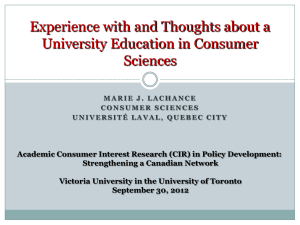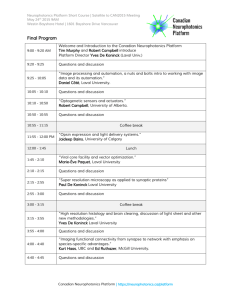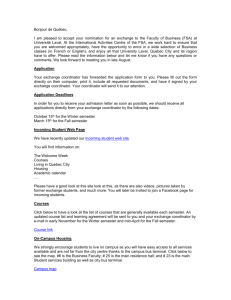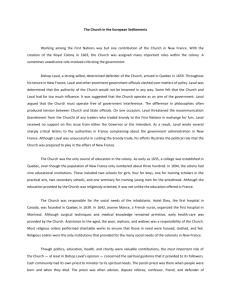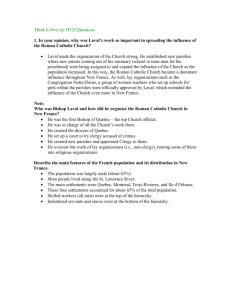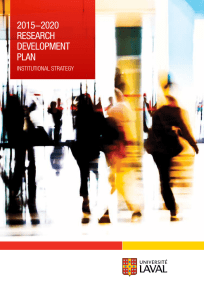Research Development Plan 2015-2020
advertisement
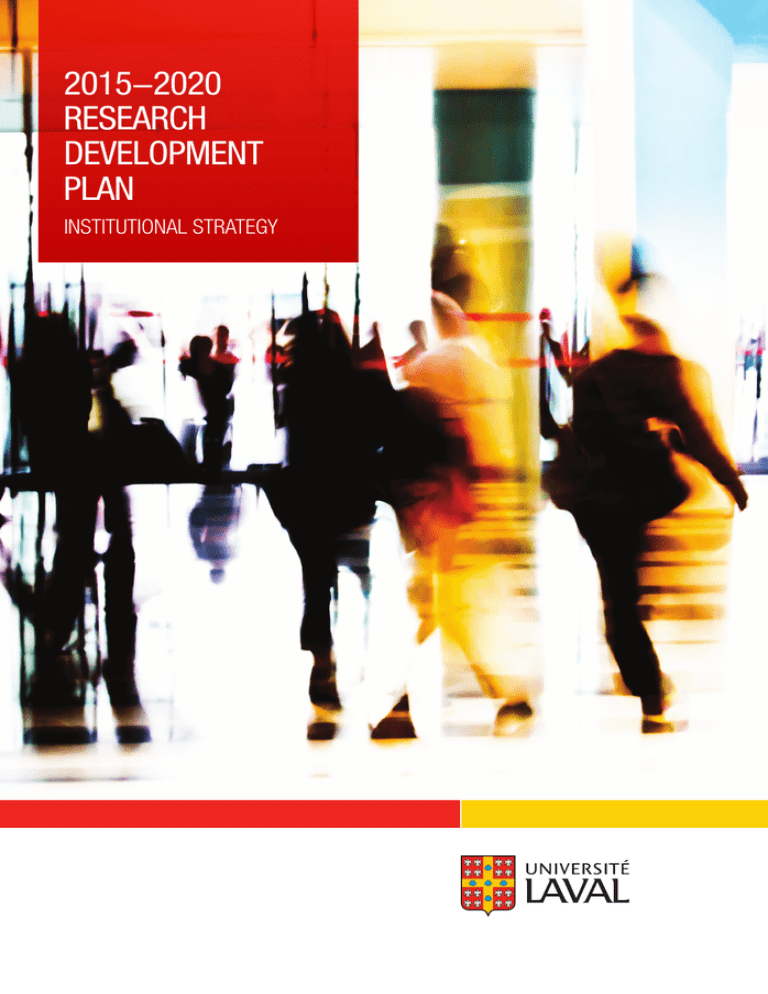
2015−2020 RESEARCH DEVELOPMENT PLAN INSTITUTIONAL STRATEGY OFFICE OF THE VICE RECTOR OF RESEARCH AND INNOVATION Pavillon des Sciences de l’éducation 2320 rue des Bibliothèques, Suite 1434 Université Laval Québec City, QC G1V 0A6 418-656-2599 Fax: 418-656-2401 vrr@vrr.ulaval.ca vrr.ulaval.ca Table of contents Background 2 About Université Laval 6 Our vision 10 Our strategy 12 Orientation 1 : Mobiliser autour des défis de société 15 > Façonner une société où la santé et le bien-être sont durables 16 > Expliquer le développement de l’humain dans son environnement 22 > Comprendre les sociétés, leurs cultures et leurs arts 28 > Modeler les communautés intelligentes, inventer leurs technologies et leur logistique 34 > Gérer et valoriser les ressources naturelles de manière responsable 40 > Consolider et développer le nord durable 46 > S’engager activement dans l’éthique, la saine gouvernance et l’organisation sociale 52 Orientation 2 : Soutenir la structuration et le rayonnement de la recherche 40 > Soutenir et mettre en valeur l’excellence en recherche et en création 58 > Stimuler et mettre en valeur le partenariat et les collaborations régionales, nationales et internationales 62 > Appuyer la recherche par et pour la formation et mettre en valeur les réalisations des étudiants 63 > Appuyer et mettre en valeur l’innovation 64 Conclusion65 Annexe66 Background The research environment has undergone tremendous transformations in recent decades, pressured by scientific challenges and inherently complex societal and economic issues that call for solutions unconstrained by national boundaries. This requires the pooling of expertise from various sectors and the sharing of available resources. More than ever, the future of our societies hinges on creativity and the ability of all concerned actors to innovate. The 2015–2020 Research Development Plan (the “Plan”) is the product of an environment that reinforces the need for new approaches based on collaboration, public-private ventures, and an international outlook. The ability to quickly and effectively capitalize on opportunities to strengthen areas with strong potential and to develop new areas and partnerships by making full use of institutional resources is becoming a major priority. This Plan follows upon its predecessor, which saw research funding increase upwards of $20 million, and PhD student enrolment grow 10%. During the period covered by the previous plan, the number of partnership chairs increased by 35%. 2 2015-2020 RESEARCH DEVELOPMENT PLAN The 2015–2020 plan builds upon major infrastructure, including facilities developed within the past five years, such as the Laboratoire de physiologie intégrative en sciences animales, Laboratoire de sustainable development des infrastructures publiques, la Plateforme de génomique intégrative humaine et microbienne, and Laboratoire audionumérique de recherche et de création. The Plan continues the high visibility achievements of late, including Alliance health Québec and Institut nordique du Québec. And like its predecessor, it leverages Université Laval’s position as a leader in the francophone world and in sustainable development. The university’s location in a vibrant, outward-looking city further adds to its appeal. The 2015–2020 Research Development Plan ties in closely with Université Laval’s Horizon 2017 action plan, in terms of research and innovation. It has been specifically developed to help attain four of Horizon 2017’s nine objectives: > Step up the internationalization of training and research, as well as our international cooperation initiatives; > Ensure effective development of research and innovation; > Attract and recruit more professors and foster faculty loyalty to contribute to institutional development; > Nurture the commitment and contributions of members of the university community and enhance the university’s reputation The actions identified to attain these objectives are an integral part of the present plan, inasmuch as they involve research, and are identified as such throughout the document. In addition to these contextual elements, the Plan is built on the expertise and influence of UL professors who are recognized as international leaders in numerous fields, and on their ability to develop new niches where unexpected scientific advances can occur. It is also based on an academic community whose members have excelled at collaborating with partners both here at home and the world over. 3 The Plan is further based on the remarkable innovation capacity of UL educators, the creativity of the graduate and post-doctoral students who help map out our future, and the skills of the research professionals who help keep projects running day in, day out. Lastly, the Plan draws inspiration from the concerns of regular citizens, whose increasingly important contributions enrich and influence the priorities and practices of our academic faculty. The Plan grew out of an ambitious consultation conducted in 2014 within the university community and its affiliated centres. UL’s scientific community will also be called upon in the course of implementation to update Plan priorities. The Plan is meant for all UL members as well as the university’s various private and public partners. The document also constitutes an important reference tool for the institutional programs run by Fonds de recherche québécois and the federal research councils. Professors requesting financial aid under these programs must demonstrate that their research efforts reflect the institutional priorities set forth in the Development Plan. The Plan also draws on faculty development plans. UL faculties, which are attuned to both global scientific trends and local needs, are the anchor point for the university’s current and emerging research capabilities. With the help of professors working in collaborative networks at the international level, they can bring a unique dimension to the university’s institutional priorities, while at the same time ensuring an exceptional convergence of effort. By linking faculty and institutional means for action, the university can boost its leverage tenfold. 4 2015-2020 RESEARCH DEVELOPMENT PLAN The mission of the Office of the Vice Rector of Research and Innovation is to develop an institutional vision for research by identifying key priorities. The office takes the lead in research development by introducing strategies to spur and optimize funding opportunities. And it brings together and implements the conditions that enable faculties to achieve their goals from an institutional perspective. The 2015–2020 Research Development Plan differs primarily in its systematic effort to delimit a vast range of activities in connection with two major priorities and seven societal challenges. The Plan’s strategic approach is also distinctive, focusing on dialogue between research teams and close collaboration with public and private partners at the local, national, and international levels. The Plan also highlights Université Laval’s ability to help answer high-priority questions confronting various research institutions and research users from the economic, social, and political arenas with respect to such challenges as sustainable development, health and wellness, good governance, Northern development, and the cultural vitality of our society. The skills and expertise of UL faculty members, professionals, students. and post-doctoral fellows in the area of research and innovation will help UL expand its influential role in the scientific, social, cultural, economic, and technological development of our globally oriented society. 5 About Université Laval Université Laval, a leading research institution, is ranked among the top ten research universities in Canada by Research Infosource Inc. With 3 Canada Excellence Research Chairs and 84 Canada Research Chairs, UL ranks sixth in terms of funding obtained from the main federal granting agencies, and its research teams are known worldwide for their performance. The university is home to numerous world-class scientific experts, many of whom are widely cited authorities in their fields. It also has some 50 major research platforms that ensure it remains competitive. 6 2015-2020 RESEARCH DEVELOPMENT PLAN Université Laval is an important actor in the community, as shown by the many contractual agreements of different types it has. Faculty members regularly establish long-lasting partnerships with community organizations, social enterprises, and private businesses throughout the Québec City area, especially in technology-related fields. The institution is also an important economic contributor to the city and region. Over the term of the current five-year plan, its research investments will exceed $1.5 billion, helping to attract top specialists and the most promising students. Université Laval is an international institution. The number of international students has risen steadily, and they now comprise 12.5% of the overall student body and 25% of graduate student ranks. UL professors collaborate with peers from all over the world, and 46% of articles published are joint publications with institutions outside Canada. The numerous formal agreements signed with non-Canadian universities and the many articles produced by faculty with co-authors from the U.S., Europe, and Asia, attest to our international worldview. Multi-national units and consortiums with France, Brazil, Switzerland, and England are another aspect of the growing trend to international research collaborations led by UL. Université Laval is an institution that embraces innovation, as evidenced by its many invention disclosures, commercial licences, and agreements for the use of research results. The university is actively engaged in the innovation chain, in keeping with governmental policies designed to stimulate the transfer and use of knowledge. UL also recognizes the benefits that derive in all areas from social and cultural innovation. 7 Well before granting agencies encouraged them to do so, UL research professors were in the habit of working together. Université Laval established centres and institutes that cut across faculty boundaries, encouraging the creation of high-level networks of deep, diversified expertise and instilling a penchant for dialogue and knowledge transfer with various spheres, and offering students and post-doctoral fellows a particularly stimulating learning environment. More recently, Université Laval has pioneered a unique capacity-building collaborative model by establishing partnership research chairs that further strengthen already productive relationships with private and public partners alike. Université Laval’s 70 partnership chairs have spawned the development of high-potential niches that have been particularly effective in training a highly qualified workforce. Through its efforts to build research capacity, Université Laval has acquired tangible means to deal with the changing research landscape. By establishing partnership agreements with other leading universities and organizations, UL is gaining in stature at the international level. For many years the university has played a unifying role, convening diverse resources to address regional issues. 8 2015-2020 RESEARCH DEVELOPMENT PLAN Université Laval teaching and professional resources, chairs, centres and partners (2013) 16 1,350 $307 M 150 400 700 faculties full-time professors million in research revenue research-oriented master’s and PhD programs, with nearly 4,300 graduate level students post-doctoral fellows research professionals 800 84 68 Université Laval strategic private/public partner-investors 3 Canada Excellence Research Chairs Canada Research Chairs 39 recognized research centres partnership research chairs 9 institutes 4 affiliated research centres 9 Our vision In order to fully play its role within Québec and Canadian society and the international scientific community, Université Laval will work to consolidate and enhance its stature as a major research and innovation institution that embraces the future and is open to the world. Université Laval will continue to serve as a cornerstone of its community, both through its humanist approach and its ability to educate tomorrow’s leaders, and undertakes to expand the frontiers of knowledge by ensuring its transfer and creating innovative, sustainable solutions. 10 2015-2020 RESEARCH DEVELOPMENT PLAN OUR VISION IS BASED ON THE FOLLOWING VALUES: Curiosity Question, break new ground Creativity Innovate, create, ideate Openness toward others Collaborate, break down barriers between disciplines, actors, and communities Integrity Pursue excellence, be transparent and intellectually rigorous Commitment Join together to tackle major societal challenges from a sustainable development perspective Leadership Explore new ways to conduct research, innovate, and develop partnerships 11 Strategy To make this vision a reality, Université Laval has adopted a strategy based on the belief that tomorrow’s solutions to the complex questions of today will emerge from a solid research and innovation base and the interplay between key disciplines. This strategy is expressed in two main priorities: 1) Mobilize the Université Laval scientific community around seven major scientific and societal challenges that transcend institutional structures and correspond to our current research strengths and paths to future development; 2) Support research capacity building and dissemination. 12 2015-2020 RESEARCH DEVELOPMENT PLAN Priority 1: Mobilize around societal challenges Université Laval wants to play a role in solving societal issues by building on its research and innovation strengths in each of its disciplines, developing high-potential emerging fields, adapting to rapid changes in research, encouraging cross-disciplinary collaboration among its professors, and supporting membership in these communities of interest. The research strengths and emerging fields identified in the Plan are the result of an analysis of several thousand projects currently under way at the university. This analysis formed the basis of a capstone effort articulating research activities for seven focus areas, each corresponding to a major scientific or social challenge. In the case of the first and sixth challenge, UL professors, their research teams, and university partners are already hard at work within a structured and evolving framework. For the other five, the Office of the Vice Rector of Research and Innovation will organize forums for the purpose of refining the strategic priorities and convening partners to address shared issues. The Plan is therefore a dynamic, unifying tool. UL research team discoveries are helping to: 1.1. Create a society where health and well-being are sustainable; 1.2. Explain how humans develop in their environment; 1.3. Understand societies, their cultures and their arts; 1.4. Model intelligent communities, invent their technologies and their logistics; 1.5. Manage and develop natural resources in a responsible manner; 1.6. Consolidate and develop Northern sustainability; 1.7. Engage actively in ethics, sound governance, and social organization. 13 Priority 2: Build research capacity and support the dissemination of Université Laval research through four areas of action: 2.1 Support and promote excellence in research and innovation 2.2 Stimulate and promote regional, national, and international partnerships and collaborations 2.3 Encourage research through and for training, and promote the achievements of students and post-doctoral fellows 2.4 Encourage and promote innovation 14 2015-2020 RESEARCH DEVELOPMENT PLAN
